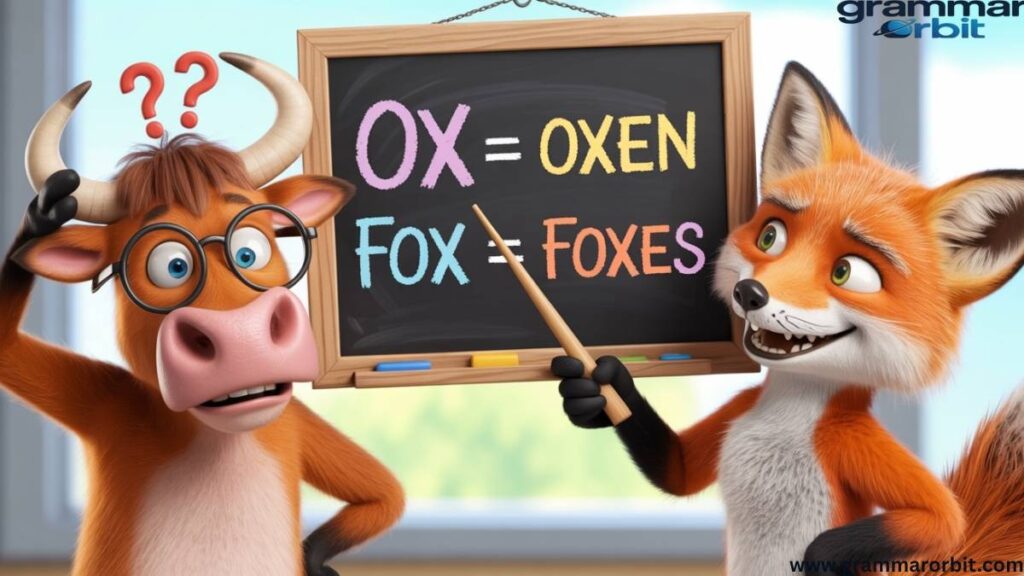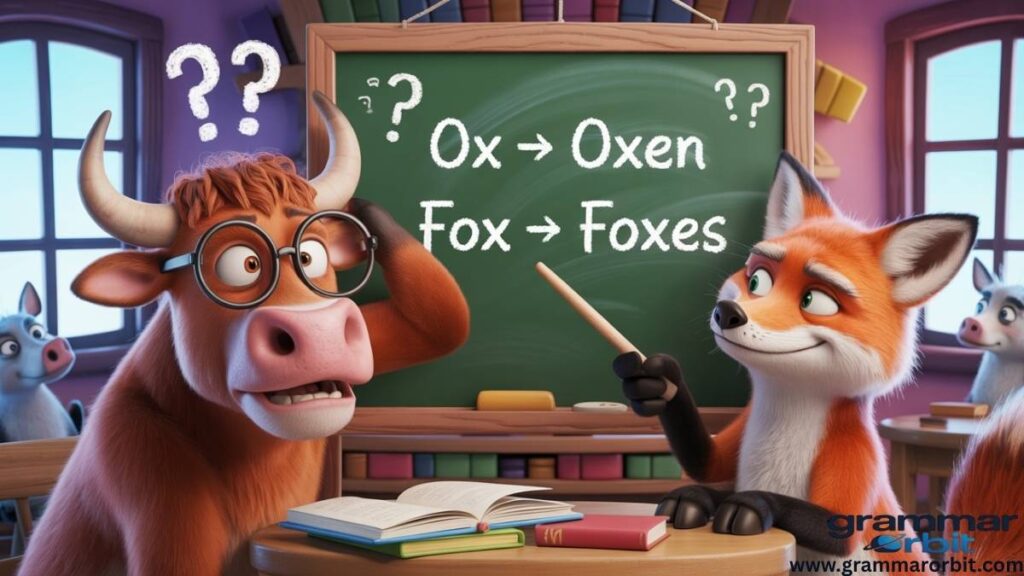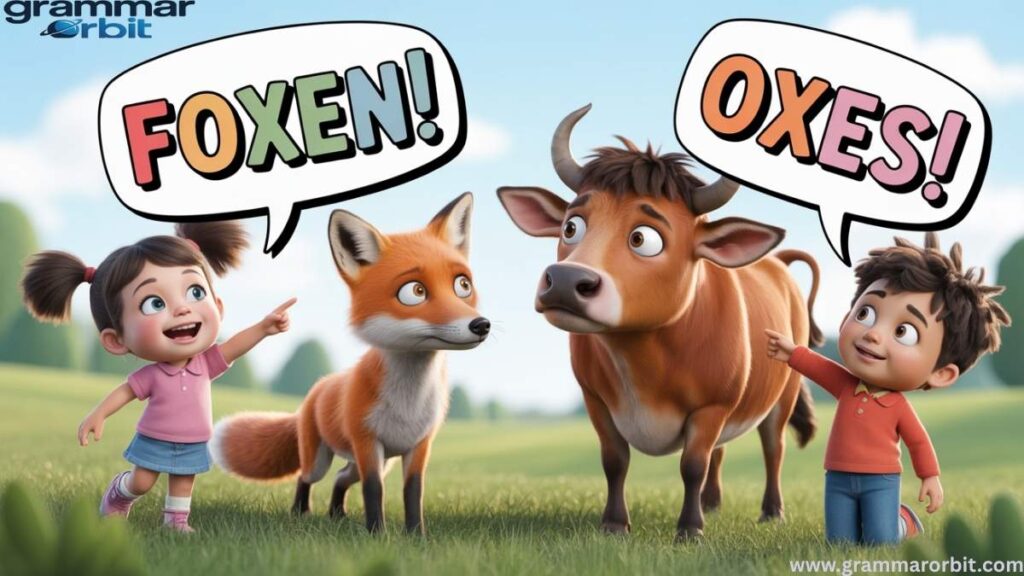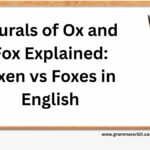Ever wondered why we say oxen but foxes and not oxes or foxen? Welcome to the wonderfully weird world of English grammar, where the plurals of ox and fox refuse to play by the same rules. One seems to have come straight out of an ancient farmyard, and the other just tacked on an es like a normal word. If that sounds confusing, you’re not alone! The oxen vs foxes debate has puzzled learners (and even native speakers) for centuries. So, grab your grammar boots we’re about to wrangle some words, chase a few linguistic foxes, and finally settle why these plurals make English delightfully unpredictable.
Singular Forms: Ox and Fox
Let’s start with the basics before jumping into plural rules.
The word ox refers to a large, domesticated animal from the cattle family, often used for heavy labor on farms. An ox is strong, dependable, and has been part of human civilization for thousands of years.
The word fox describes a small, clever animal known for its intelligence and beautiful bushy tail. Foxes are famous in fables and folklore as symbols of wit and trickery.
Example sentences
- The ox pulls the cart across the muddy field.
- The fox hides behind the tall grass, waiting to pounce.
Both words are nouns, both end in “x,” and yet they follow completely different pluralization paths.
Understanding English Plural Formation Rules
To understand why ox and fox behave differently, we need to look at how plural nouns form in English.
Regular Plural Rules
Most English nouns form their plural by adding -s or -es.
- Cat → Cats
- Book → Books
- Bus → Buses
- Fox → Foxes
When a word ends with a hissing sound such as s, x, z, ch, or sh, adding -es makes pronunciation smoother. That’s why we say foxes and not foxs.
Irregular Plurals in English
Some words, however, refuse to follow this modern pattern. These are called irregular plural nouns. They often come from Old English or other early Germanic roots.
Examples include:
- Man → Men
- Child → Children
- Goose → Geese
- Ox → Oxen
These irregular plurals survived centuries of language change, holding on to ancient patterns that no longer apply to most English words.
Here’s a quick comparison table to visualize it:
| Type | Singular | Plural | Rule |
|---|---|---|---|
| Regular | Dog | Dogs | Add -s |
| Regular (ends in x) | Fox | Foxes | Add -es |
| Irregular | Child | Children | Add -en (Old English form) |
| Irregular | Ox | Oxen | Add -en (Old English form) |
This blend of old and new rules is why English pluralization feels inconsistent at times but that’s also what gives it character.
KM Meaning in Text: A Comprehensive Guide
Why Ox Becomes Oxen

Now let’s explore one of the strangest survivors in the English language: oxen.
The Old English Origin
The word ox comes from the Old English word oxa. In Old English grammar, nouns could take many endings to show plural, case, or gender. One of those endings was -en or -an, used to form plurals for certain nouns.
Originally, the plural of oxa was oxan. Over time, this became oxen.
As English evolved, most plural forms simplified to the modern -s ending, but a few -en plurals survived. Today, the only common words that still use this pattern are oxen and children.
The Linguistic Roots of Oxen
This plural ending -en comes from old Germanic languages, which used similar endings to mark plural nouns. It’s part of what linguists call noun morphology the way a word changes form to show number or tense.
Oxen is more than just a word. It’s a linguistic fossil, preserved from a time when English looked and sounded completely different.
Example Scenario
Picture a medieval farmer saying, “The oxen are pulling the plow through the field.” That sentence would have sounded perfectly normal a thousand years ago and it still does today.
Common Grammar Mistake
Many learners assume that since most English words take an -s or -es plural, the plural of ox should be oxes. But that’s incorrect.
- Correct: Oxen
- Incorrect: Oxes
Learn the Difference Between Oversight vs Oversite
Why Fox Becomes Foxes

Now let’s look at fox, the trickster of the English language but a well-behaved one grammatically.
Modern English Rule: Add -es
The plural of fox follows the regular rule for words ending in “x.” When a word ends in that hissing or buzzing sound, English adds -es to make pronunciation easier.
So we get foxes instead of foxs.
Other examples include:
- Box → Boxes
- Buzz → Buzzes
- Match → Matches
- Dish → Dishes
The plural of fox is pronounced fok-siz and written phonetically as /ˈfɒksɪz.
Etymology of Fox
The word fox comes from the Old English word fox, which already used the -es plural ending (then spelled -as). Unlike ox, which kept its old ending, fox naturally evolved into the regular system we use today.
Example Scenario
A wildlife photographer might say, “I saw five foxes playing in the snow this morning.” Simple, modern, and perfectly grammatical.
Common Grammar Mistake
If oxen is correct, shouldn’t foxen be too? That sounds logical but languages rarely stick to logic.
Fox never followed the -en plural rule because it wasn’t part of that older grammatical group. It became regularized over time, aligning with the modern -es pattern.
- Correct: Foxes
- Incorrect: Foxen
Oxen vs Foxes: Side by Side Comparison

To make the contrast clear, here’s a quick comparison:
| Feature | Ox | Fox |
|---|---|---|
| Plural | Oxen | Foxes |
| Type of Rule | Irregular | Regular |
| Root Language | Old English (Oxa → Oxan) | Old English (Fox → Foxas) |
| Ending Used | -en (ancient plural) | -es (modern plural) |
| Example Sentence | The oxen plowed the field together. | The foxes hunted near the forest. |
| Common Mistake | Oxes | Foxen |
| Pronunciation | /ˈɒksən/ | /ˈfɒksɪz/ |
So even though both words end in “x,” one stayed ancient while the other evolved. That’s English for you a mix of history, habit, and just a pinch of chaos.
Common Confusions and Misconceptions
Here are a few myths and misunderstandings people often have about these words:
- “Foxen” sounds right, so it must be a word.
It’s not. Foxen was never a real plural in English; it’s just a playful imitation. - “Oxes” should work since that’s how most plurals form.
Not for ox. This word stuck with its Old English pattern. - Other words with -en plurals exist.
Hardly any. Children and brethren are the only common survivors.
Quick memory tip:
Old word → Old rule → Oxen
Modern word → Modern rule → Foxes
Why English Keeps These Odd Plurals
English is like a museum it collects relics from its past and puts them right next to modern inventions. The word oxen is one of those relics.
Centuries ago, English used several different plural endings. But as grammar simplified, most of them disappeared. The en plural stayed alive only in a handful of common words.
Why didn’t we just replace oxen with oxes? Because tradition matters in language. When a form is used for hundreds of years, it becomes natural to speakers, even if it’s irregular.
Examples of Other Surviving Plurals
- Child → Children
- Brother → Brethren (used in religious or poetic contexts)
- Cow → Kine (an ancient plural no longer used)
Each of these tells a story about how English evolved keeping a few old rules while letting others fade away.
Fun fact: Some languages, like German and Dutch, still have similar irregular plural systems today. So English isn’t the only one holding on to its linguistic history.
Tips to Remember the Correct Forms
Here are some simple tricks to make sure you never mix them up again.
Easy Mnemonics
- O stands for Old → Ox → Oxen
- F stands for Fresh → Fox → Foxes
Practice Sentences
- The oxen rested after pulling the cart all day.
- The foxes ran quickly through the forest.
- Never write oxes unless you’re joking.
- Never say foxen unless you’re trying to be funny.
Grammar Tip
Ancient nouns often keep ancient plurals. Modern nouns follow modern rules.
WRD Meaning in Text: A Complete Guide
A Fun Look at How Kids Say Plurals of Ox and Fox

Here’s a funny twist kids often say Plurals of Ox and Fox naturally when they’re learning to talk. Linguists call this overgeneralization. Children apply the rules they already know to every word, assuming that if cats and dogs are right, then oxes and foxen must be too.
This behavior actually proves how powerful language patterns are in our brains. Kids instinctively follow the dominant rule, even when a few words refuse to cooperate.
It’s also a reminder of how English itself evolved by speakers overgeneralizing and then slowly settling on new patterns.
Reference: Cambridge Dictionary Definitions
Here’s a trusted source for clear word meanings:
FAQs About the Plurals of Ox and Fox
What is the plural of ox and fox?
The plural of ox is oxen, and the plural of fox is foxes.
Is it correct to say oxes?
No, oxes is incorrect. The only correct plural form is oxen.
Why is the plural of ox oxen and not oxes?
Because ox kept its ancient plural ending from Old English, where certain nouns used -en instead of -s.
Why is the plural of fox not foxen?
Because fox followed the modern plural rule, adding -es like most English nouns.
Are there other words like oxen?
Very few. Children and brethren are two rare examples.
What’s the difference between oxen and foxes?
Grammatically, oxen is irregular and foxes is regular. In meaning, they refer to two completely different animals.
Conclusion
So, there you have it the wild world of oxen vs foxes finally tamed! The plurals of ox and fox may seem like a linguistic prank, but they’re really little fossils of history, showing how English plural rules evolved over time. One word clung to its Old English roots, while the other joined the modern crowd with a simple “-es.”
Next time someone says Plurals of Ox and Fox just smile and let them in on the secret English doesn’t always make sense, but that’s what makes it fun. After all, where else can grammar make you laugh and learn at the same time?
JHON AJS is an experienced blogger and the creative voice behind the website grammarorbit.com, namely Grammar Orbit. With a keen eye for language and a passion for wordplay, he creates engaging grammar insights, word meanings, and clever content that make learning English enjoyable and interesting for readers.






